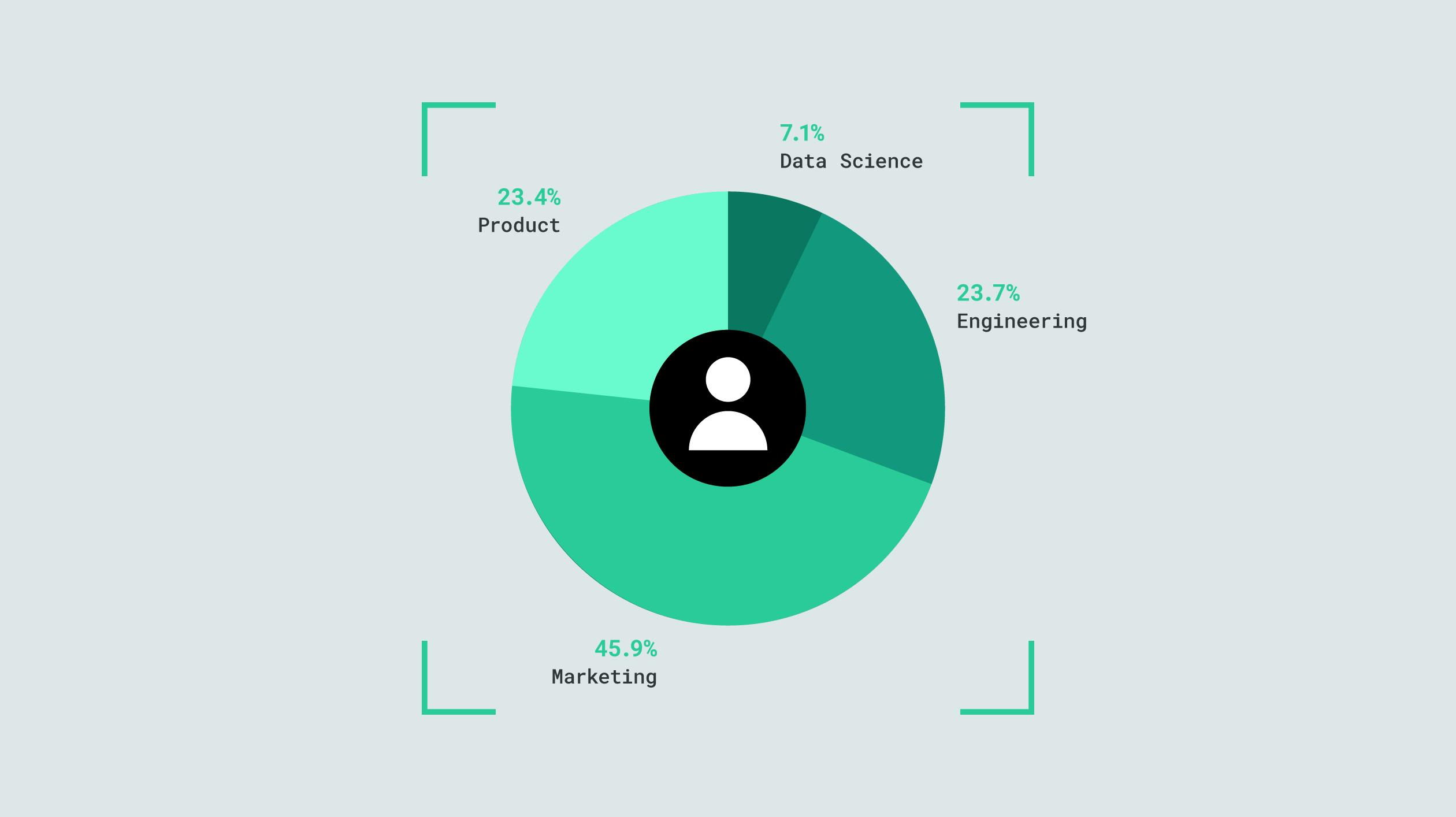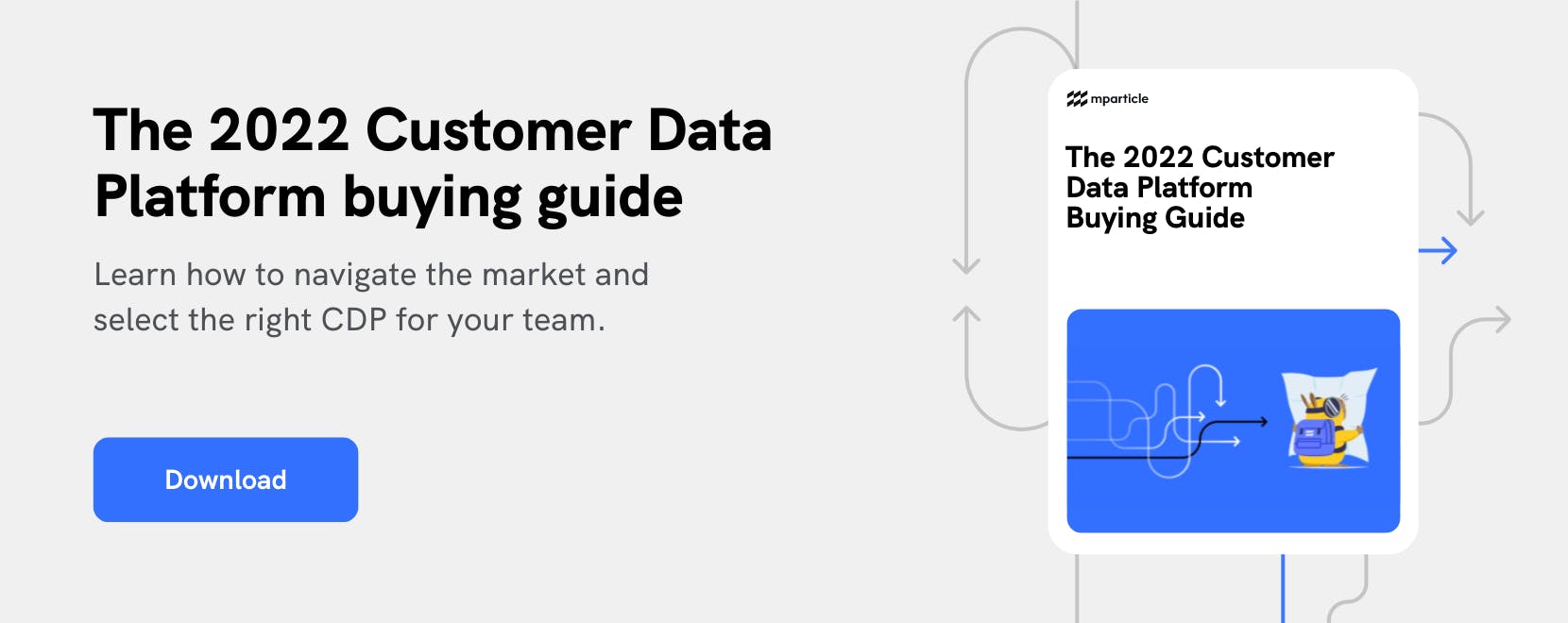How to run a complete CDP evaluation
In part one of our two-part series on making the most of your Customer Data Platform, we discuss which stakeholders should be involved in your CDP evaluation and how each can help you select the right CDP for your business.

Just as we think about the lifecycle of a customer, or the lifecycle of a product, it’s a good exercise to consider the lifecycle of a data point. From the pre-creation stage, when an event is implemented to capture information; to the action through which a data point itself is created; to the moment of activation, where it might be used to build an audience segment or trigger a push notification; and ultimately to long-term storage, where it may be queried for historical analysis.
Throughout these lifecycle stages, a data point passes through many systems and is utilized by multiple departments across the organization. Engineering may be responsible for implementing the initial event, making sure data is being created, and monitoring the systems used to collect data. Marketing may be leveraging the data point to enrich their customer profiles and power contextual campaigns. Product Management may be analyzing the data for engagement insights while also ensuring that the way data is collected, accessed, and activated by the growth team has a net-positive impact on the user experience.
It seems obvious, therefore, that decisions around the infrastructure used to pipe data throughout its lifecycle should involve stakeholders from multiple departments across the company.
Customer Data Platforms (CDP), a relatively new and rapidly evolving technology, are fundamentally changing the way that brands connect data across their tech stacks. As such, brands evaluating CDPs have expressed uncertainty around questions such as:
- Who owns the CDP?
- Which teams should be involved in evaluating and operating a CDP?
- How should a solutions partner be involved in our CDP evaluation?
In this first installment of our two-part series, we’ll walk through the steps you can take to help make your CDP evaluation a success, discussing which departments should be involved and highlighting specific considerations each stakeholder should take into account.
Which teams should be involved in your Customer Data Platform evaluation?
In reviewing data on Customer Data Platform evaluations run in the last 12 months, we uncovered that Marketing teams were responsible for leading the process 45.9% of the time. Product and Engineering departments were nearly equal in percentage of CDP evaluations led, with 23.4% and 23.7%, respectively. These findings reflect the common operating model of an implemented CDP. Marketing teams are often the end users of the Customer Data Platform, using it to access customer data and control how data flows to their application layer tools. Additionally, the purchase of a Customer Data Platform often (though not always) comes out of marketing’s budget.

Departments leading Customer Data Platform evaluations
Looking beyond these findings, however, it must be noted that although Marketing most often led their company’s CDP evaluations, stakeholders from Engineering and Product were almost always involved in evaluations as well. Product Managers need to confirm that the CDP supports the organizations’ data governance protocol and that it integrates well with their growth stack. Engineering stakeholders need to confirm that the CDP’s SDKs and APIs integrate cleanly with the company’s existing data infrastructure and that the CDP will increase developer efficiency in the long run.
Data is a team sport. As such, any evaluation of customer data infrastructure must involve key stakeholders from across the company. To help your team simplify your CDP evaluation, let’s walk through the key considerations that each department should be mindful of.
Engineering
Although routinely labeled as a tool for Marketers, Customer Data Platforms are a foundational part of data infrastructure and therefore exist within the domain of Engineering. To determine which CDP vendor is right for your organization, Engineering stakeholders need to validate that the CDP integrates well with their existing systems. Without a sustainable implementation, any downstream benefits that a CDP promises to business teams are nullified.
Beyond initial instrumentation, Engineering stakeholders also need to confirm that the CDP will make their lives easier in the long run. Implementation of new events should be simple, and any embedded kit integrations should be easy to add to the existing implementation. Furthermore, certain CDPs empower Engineering users with developer tools such as linting and CLIs, making it easier to adhere to your data schema and ensures that high quality data is logged to your workspace.
Questions that engineering stakeholders should consider when evaluating a CDP
- Does the CDP provide SDKs and APIs that I can easily deploy into our systems?
- Does the CDP provide integrations that will allow us to move third-party vendor code from the client-side to the server-side?
- Does the CDP provide developer tools that will enable our engineers to manage the implementation more easily?
- Does the CDP vendor provide developer documentation that will allow us to work with the tool independently?
Product
Customer Data Platforms provide value to Product Managers in several ways, and at the enterprise level it’s not uncommon for distinct teams within the Product org to leverage the CDP for a variety of defined purposes.
For Product Managers focused on using data to understand user engagement in an analytics application such as Amplitude or a BI tool such as Looker, CDPs provide the data infrastructure that enable you to connect data to downstream tools based on your forwarding choices so that it can be used to draw meaningful conclusions. When evaluating CDPs for this purpose, it’s important to investigate not only data collection and integration capabilities, but also each vendor’s data quality features. Without clean, accurate, and consistent data flowing into your analytics systems, all insights may be compromised.
For Growth Product Managers focused on improving the integrity of the data pipeline, Customer Data Platforms present a transformation of the way in which customer data is managed. By eliminating data silos, creating a unified view of the customer, and providing Marketing with instant access to real-time customer data without Engineering dependency, CDPs make the vision of building an interconnected, best-in-breed tech stack a reality. However, with a cluttered and confusing CDP market, it’s important to differentiate between which CDP providers are providing reality and which are providing a facade. The best way to do so, besides evaluating a vendor’s capabilities for collection, identity resolution, and integration, is to conduct customer references and trial specific use cases.
Customer Data Platforms also benefit Product organizations by improving developer productivity. Without a CDP in place, developers are consistently called to assist business teams with vendor SDK implementations and updates, .csv data uploads, data quality management, and other tedious tasks. These requests pull developers away from core development, introducing the impact of context switching, delaying the launch of customer-facing initiatives, and putting the product roadmap at risk. By enabling business users to connect data to downstream applications within the UI, CDPs free developers from having to support ad-hoc requests from Marketing. When evaluating a CDP, validate with your developers that the CDP provider’s client-side SDKs are well built and will fit into your existing architecture. This will ensure that the CDP will truly free developers from ongoing third-party code management. Additionally, investigate what each CDP does to make developers’ lives easier – leading CDPs will provide developer tooling that assists with event implementation, data quality management, and more.
Questions that product stakeholders should consider when evaluating a CDP
- Does the CDP have the capability to collect all of the data I need to understand product performance and user engagement
- Will the CDP help you save engineering resources in the long run?
- How will the CDP implementation impact app/website load speed?
- Will the CDP enable us to resolve cross-channel data to unique customer profiles?
- Will the CDP enable use to process Data Subject Requests, collect customer consent state, and control data forwarding based on consent or any other chosen lawful basis?
- Does the CDP integrate well with the tools and systems used across our growth stack?
Marketing
Growth Marketing leaders are heavily involved in Customer Data Platform evaluations because they are the stakeholders that are most active in the CDP once it has been implemented. Specifically, functions such as setting up event forwarding, profile lookups, and audience building are all completed by Marketing stakeholders within the CDP UI. When evaluating vendors, marketers should inspect how easy it is to carry out these core functions in each CDP, and confirm that they can be completed without developer support.
For integration capabilities in particular, marketers should validate that the CDP integrates with all the tools and systems across their tech stack. If there are gaps that the CDP provider promises to fill, it’s important to assess their capability on delivering those updates. Additionally, it’s important to confirm that integrations are easy to connect, and that you’ll have the ability to control which events are sent to each destination within the UI.
When evaluating a CDP’s audience building capabilities, it’s important to validate that the platform’s UI makes it easy to build segments and connect them to downstream systems in real time for activation. Advanced audience features that you can look out for are audience size estimation, audience A/B testing, and audience downloading.
Questions that marketing stakeholders should consider when evaluating a CDP
- Is the UI clear and easy to use?
- Does the CDP make it possible to access a unified view of the customer without developer support?
- Does the CDP have an intuitive audience builder that enables you to build segments without developer support?
- Does the CDP have packaged integrations with all of the other tools in your growth stack, and do those integrations enable you to forward events and audiences in real time?
- Will having the CDP in place make it easier to deliver personalized customer experiences?
- Can you use the CDP on a day-to-day basis without involving a developer?
How can a solutions partner help with your CDP evaluation?
Solutions partners can provide valuable assistance to your Customer Data Platform evaluation. Below, Thierry Sequeira, CEO of European-based digital growth agency Massive Rocket breaks down the way in which his team supports brands as they procure CDPs.
1. Assessing business needs
Each business is unique: team, technology, business model and customers. Solutions partners such as Massive Rocket provide a point of view to understanding your brand, your business and more importantly, your customers. How are they engaging? What channels are they using? What are their needs and pains?
We will also carry out internal stakeholder interviews to map out all the key use cases you might have for a CDP. Finally, we’ll work with you to prioritize their use cases based on level of effort, impact and speed of delivery, using this as the project brief to then select the appropriate technology solutions.
Customer Data Platforms have become the foundation of modern customer experiences and customer engagement. They are what enable you to connect your product and communications and build human experiences. However, the CDP market has grown incredibly fast and become more complex in recent years. The way you select, roll out and scale CDP solutions across your business can ultimately dictate how fast your business grows.
CEO of Massive Rocket
2. The market
One of Massive Rocket’s biggest strengths is the depth of our connection with todays’ market. We speak to CEOs, CTOs, CMOs and CPOs at the largest and fastest growing businesses every day to understand what technologies they use as enablers, how they are structured and what processes they deploy to be more efficient.
We gather all the information that we have pulled together from the business we are working with and the market to make an assessment that will provide the best possible solutions to the highest priorities needs in the shortest possible time.
Up next: Stay tuned for part two of the series, which will focus on how you can set up a team of 'customer data excellence' to get the most out of your CDP.




